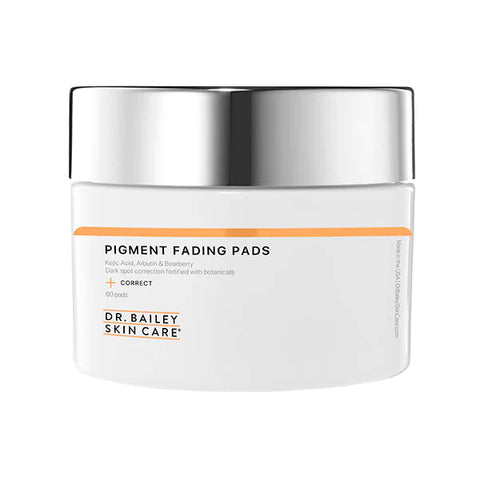Melasma - its causes, signs, and treatments
By Cynthia Bailey MD.

Melasma is a troubling skin pigment problem that many people struggle with. Learn about melasma from the dermatologist. Gain a better understanding of the causes of melasma, how it appears on a person's skin and what skin care treatments are available to both help and prevent melasma.
What is Melasma?
Melasma, formerly called chloasma, is a pigment problem typically of facial skin.
What causes melasma?
The exact cause is unknown but hormones, sun damage and genetics play a role. We do know about melasma is that:
- UV rays cause pigment cells in the skin, called melanocytes, to make too much pigment. They do this in response to free radicals that form when UV penetrates skin.
- Visible light, such as from indoor lighting and digital device blue light, can also cause melasma.
- Cells in the skin, called melanophages, gobble up the pigment and hold it in the skin. Normally pigment fades, but these cells store it so the color does not go away easily.
- The skin is active and something 'extra' is going on because there are also more capillaries in the parts of skin with melasma and other cells in the skin are more active, such as dermal fibroblasts and immune cells. Interestingly, melasma can even itch and sting.
- In the skin where melasma exists, there is also evidence of sun damage in the dermis (changes in elastic fibers).
All this means that melasma is complex physiologic process. We have not figured out entirely what is going on – but the skin is very busy, including making and holding onto pigment!
What role do hormones and birth control pills and pregnancy play in melasma?
Hormones make melasma worse, but we don’t know how and why. It is not the level of hormones that is the issue, it is some other mechanism such as hormone receptors in the skin. We know that when a woman takes birth control pills, her melasma can worsen. Oddly, you can’t just lower the dose of birth control pills to lower the risk of melasma. Unfortunately, you need to stop using the pills entirely if you want to reduce the risk of getting melasma from birth control pills.
Who gets melasma?

9% of women will have melasma at some point in their lives, especially during their reproductive years. Most people with melasma are women, but men can get it too.
What are the signs of melasma?
Hyperpigmentation of patches of skin on the central forehead, above the eyebrows, on the cheek bones, upper lips, and side of the face. Melasma typically does not cause pigment of the skin within the eye socket, below the jaw bone, on the tip of the nose or down the sides of the neck. Patches of melasma hyperpigmentation are typically curved and not straight.
What hyperpigmentation skin problems can mimic melasma?
- Pigment down the sides of the neck may look like melasma but it is more likely to be Poikiloderma of Civatte, a form of hyperpigmented sun damage.
- Sun spots are typically discrete and present asymmetrically in parts of skin that has had a lot of sun exposure.
- Drug induced hyperpigmentation and lichen planus pigmentosis (you need to go to a dermatologist for these diagnosis)
- Post-inflammatory hyperpigmentation from healed acne lesions, injuries or rashes.
What is the best skin treatment for melasma?
Your skin care routine is the best way to get rid of melasma.
Melasma is a stubborn skin problem. To control melasma, your skin care needs to be strong and consistent, hitting melasma at every possible mechanism that drives it. I created a skin care kit with professional level active ingredients for each step in the melasma pigment process. I call it my Ultimate Pigment and Sun Damage Repair Kit. It treats the pigment problem of melasma, sun spots and sun damage all in one skin care routine with the best proven ingredients.
Treat melasma with skin lighteners that are tyrosinase inhibitors.
Tyrosinase is the skin enzyme that is most important for making skin pigment (called melanin). Tyrosinase inhibitors stop the skin's pigment producing cells (called melanocytes) from making melanin. The best tyrosinase inhibitor is hydroquinone, which is available only by prescription. Other tyrosinase inhibitors include arbutin, kojic acid, azelaic acid. These don’t work as well as hydroquinone but can be helpful and provide an excellent hydroquinone-free option for reducing skin pigment in melasma.
How to taper off hydroquinone
Most dermatologists use hydroquinone in a pulse dosing fashion. This is because hydroquinone can cause itching and redness. It has also been reported to produce rebound hyperpigmentation, especially when used at high prescription concentrations over 6%.
I have used hydroquinone for years in my practice and I typically recommend using hydroquinone for a maximum of 4 months then tapering off. My Pigment Fading Pads contain hydroquinone-free botanical tyrosinase lighteners . I recommend using the pads in a skin care routine that also includes other pigment lightening products such as retinoids and glycolic acid combined with broad spectrum sunscreens. This comprehensive approach helps maintain benefit and continues to improve melasma.
Tyrosinase inhibiting products will reduce melanocyte melanin production so that the skin can't hang onto the melanin. I like to combine botanical lighteners such as arbutin with kojic acid and antioxidants. This is the basis of the formulation in my Pigment Fading Pads. Azelaic acid works too but can be irritating. Vitamin C will help inhibit tyrosinase but product formulation is difficult because this fragile molecule readily degrades on contact with air. Another product called Cysteamine Cream also inhibits tyrosinase. It is available without prescription but smells like rotten eggs. We are expecting new products soon that don't have the smell.
Fight melasma with ingredients that exfoliate skin, reduce sun damage and turn down tyrosinase.
The tyrosinase inhibitors will penetrate skin better if you also use retinol and glycolic acid products such as my Retinol Anti-Wrinkle Night Cream and Glycolic Acid Face Cream. These two ingredients also down regulate (turn down) tyrosinase and increase skin cell turnover to help shed pigment.
What is the best SPF for melasma?
Prevent melasma by wearing a broad spectrum SPF 30+ sunscreen with 5% or more zinc oxide that contains iron oxide every day.
It is really important to block UV rays that lead to pigment formation. You need to block visible rays too and you do that with products that contain iron oxide. My Sheer Strength Pure Physical Matte Tinted SPF 50+ Sunscreen gives you both UV and visible light protection. Top it with mineral powder for even more iron oxide protection. Ideally, you want a full 3.2% or more iron oxide on your melasma-prone skin and my Sunscreen gives you that.
What is the best skin care routine to fix melasma?
Remember you get the best results with Complete Skin Care. Dr. Bailey’s Complete Skin Care involves the 4 essential skin care steps of,
- CLEANSE
- CORRECT
- HYDRATE
- PPROTECT
CLEANSE skin with a gentle cleanser. Using a non-irritating toner will help remove any residual dirt and skin oil to enhance penetration of products as well.
CORRECT with Pigment Fading Pads followed by Glycolic Acid Anti-Wrinkle Cream. At night use a retinoid such as a my Retinol Ultra-Intensive Anti-Wrinkle Night Cream. Because inflammation may drive melasma, I add Green Tea Antioxidant Therapy™ an important product to help calm inflammation naturally and safely.
HYDRATE to balance skin moisture and help your skin tolerate this intensive treatment routine. Use a product without conflicting ingredients to your correcting products. My Daily Moisturizing Face Cream is formulated to be compatible with this routine and provides ceramides and squalane to support the skin's barrier integrity.
PROTECT skin from UV and visible light using a broad spectrum zinc oxide sunscreen and a product with a robust concentration of iron oxide. My Sheer Strength Pure Physical Matte Tinted SPF 50+ Sunscreen gives you both and is the best choice for melasma. If you wear a foundation or mineral makeup, apply it on top of the Matte Tinted Sunscreen. Some powders, such as my Pressed Mineral Makeup Powder have a lot of iron oxide to provide additional protection against visible light.
Best Dermatologist-Approved Melasma Skin Care Routine
You can see that I've left nothing to chance when treating melasma:
- I prep your skin to absorb the important treating active ingredients,
- I include all the best ingredients to fade pigment, neutralize free radicals and calm the inflammation that drives melasma,
- I've created the most complete sun protection strategy so that melanin production is not stimulated by UV or visible/digital blue light exposure.
This is what it takes to fade melasma; melasma is stubborn and this approach meets it head-to-head!
Does this sound overwhelming? It can be. That's why I created my Ultimate Pigment and Sun Damage Repair Kit to take out the guess work. It's the synergy of this product combination that works the magic!
- I use skin tyrosinase inhibitors including arbutin and kojic acid to help turn off melanin production.
- Retinol and glycolic acid enhance penetration and also have their own mechanisms for turning down pigment production.
- Green Tea Antioxidants to fight free radicals and inflammation that's always seen in skin suffering from melasma. They also help skin to tolerate this professional skin care routine built from powerful products.
- Sheer Strength Pure Physical SPF 50+ Matte Tinted Broad Spectrum Sunscreen blocks UV induced skin pigment formation and also contains the right amount of iron oxide to help reduce skin exposure to blue digital and visible light both known to contribute to skin pigmentation problems. Adding a mineral makeup with iron oxide will also help augment the iron oxide and mineral particle light protection for your skin.
I've built the kit with the best skin cleansing routine and moisturizer to help products penetrate and skin to tolerate this powerful complete routine to fight hyperpigmentation. My kit product page includes detailed instructions to help you achieve success!
How long does it take for melasma to improve?
Once you start a good skin care routine to fight melasma, improvement time will vary for each person. Sometimes results happen quickly, other times the struggle takes much longer. Laser and skin care procedures don’t often help and the most important treatment is a good skin care routine. This is why an intensive skin care routine is important.
New developments in the treatment of melasma
Tranexamic acid is a medicine that appears to inhibit many of the driving pathophysiologic mechanisms of melasma. It has been available in the U.S. since the 1960s for treatment of heavy menstrual periods because it slows the breakdown of blood clots (it is an antifibrinolytic). Right now, the best results for melasma are seen when it is used orally. No one knows how safe it is to use this medicine long term, however, and melasma would require long term usage. Oral tranexamic acid can cause blood clots and damage to kidneys, heart and lungs. Topical treatment for melasma has not shown very impressive results.
Click here to learn more about the Ultimate Pigment and Sun Damage Repair Kit, a skin care routine designed to fade melasma.
Watch the video below for more information on Melasma.
References:
Shankar Krupa, et. al., Evidence-Based Treatment for Melasma: Expert Opinion and a Review, Dermatol Ther, 2014 Ded; 4(2): 165-186
Ogbechie-Godec OA, Elbuluk N. Melasma: an Up-to-Date Comprehensive Review. Dermatol Ther (Heidelb). 2017;7(3):305‐318. doi:10.1007/s13555-017-0194-1
Handel AC, Miot LD, Miot HA. Melasma: a clinical and epidemiological review. An Bras Dermatol. 2014;89(5):771‐782. doi:10.1590/abd1806-4841.20143063
Wang JV, Jhawar N, Saedi N. Tranexamic Acid for Melasma: Evaluating the Various Formulations. J Clin Aesthet Dermatol. 2019;12(8):E73‐E74.
Melasma, American Academy of Dermatology, 2018 https://www.aad.org/public/diseases/color-problems/melasma



